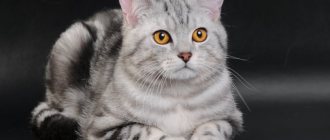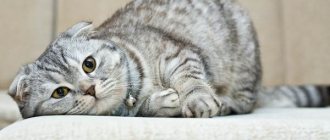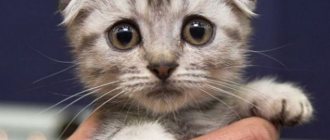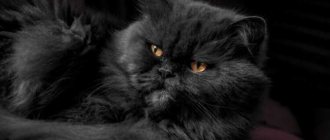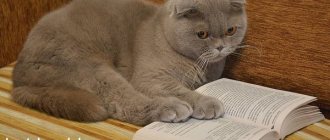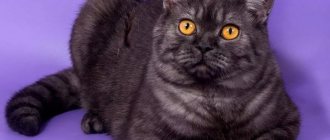With the appearance of a little fluffy Scotsman in the house, a lot of questions arise about the care and nutrition of the baby. In another situation, it is interesting to find out about the character of the cat and the characteristics of its health before deciding to purchase such a miracle.
Who is the Scottish Straight cat, how did he appear and what distinguishes him from the so similar British cat.
And it was like this
On a Scottish farm, almost 60 years ago, a cat named Susie was born. Later, the owner of the farm noticed an amazing feature of the kitten - her ears were bent and smaller than usual. Otherwise, the kitten was no different from its mother.
Over time, the fold-eared cat was noticed by the British scientist William Ross. And he took the girl to him.
When Susie became a mother herself, one of her cubs again turned out to be a kitten with drooping ears. Since then, Ross began breeding the breed. Both regular and fold-eared kittens were born in the litter.
As we studied the breed, it turned out that this feature of the ear structure is due to a defective gene. And this gene brings with it health problems, including disability of the animal.
So the breed was banned in Great Britain, and the Scots went to America. There, scientists crossed the Scottish Fold cat with the British Shorthair. The result was kittens with normal ears and drooping ones.
But the latter no longer had a great genetic predisposition to diseases. After all, 2 thirds of their genes were healthy, which means that only minor health features remained - a tendency to diseases of the joints and cardiovascular system.
Colors
Felinologists identify the basic colors of the Scottish Straight cat:
- black;
- blue;
- chocolate;
- lilac;
- cinnamon (milk chocolate);
- fawn (light cinnamon);
- cream;
- red.
The main background may contain various patterns: brindle, spotted, marble. In addition, there are variations with white colors: medallion, bicolor, harlequin, van, exclusively white. Cats of colors with silver look great: smoky or silver drawn, shaded, chinchilla.
There are a group of golden colors: ticked, shaded, golden chinchilla. There are also straight point colors with all sorts of variations in shades and patterns.
The group of tortoiseshell Scots is not inferior in number. Often there are cats of patchwork, solid, painted colors, as well as calico.
Plain (solid)
Solid colors are characterized by monotony. There are no patterns, markings or ticking on the coat.
Varieties:
- Dazzling white. The iris is amber, blue. The nose and paw pads are pink.
- Pure black. The iris is amber, the nose and paws are dark, blending in with the fur.
- Blue with dark gray edge. Amber iris. The nose and paws are gray.
- Lilac - the coat is light gray, transitioning to cream. Amber iris. The nose and paws match the color.
- Red with a fiery edge. The iris is amber, the nose and paws are the same color as the fur.
- Cream - light peach colored coat. The iris is golden. The nose and paw pads are pink.
- Cinnamon is a cinnamon color, reminiscent of milk chocolate. The nose and paw pads are pink-brown.
Bicolors (two-color)
Varieties:
- Bicolor is a combination of basic white with blue, black, cream, and red. The muzzle, belly, legs and thighs are light, without inclusions. Eyes are golden or blue. Heterochromia - different colored eyes - is also common.
- Van - the main color is white, but there are dark markings on the tail and head. The iris is golden or blue. Heterochromia is characteristic.
- Harlequin has a white edge and only 1/5 of the fur is colored.
Color point
There are no patterns on the body, which is why it contrasts with dark blotches on the muzzle, paws and tail.
Varieties:
- blue point (white with light blue);
- seal point (cream with dark brown);
- lilac point (white with lilac);
- Choclet point (white with brown);
- cream point (light cream with cream);
- tortoiseshell with red or cream spots;
- tabby point (striped pattern).
Reference. Pointed cats are born with a gene that causes hairs on parts of the body such as the face, paws, tail and ears to darken when body temperature is low. In these places there is weaker blood circulation, which is why the color is darker.
Scots have a color-point sky blue iris.
Tortoiseshells
There are fire and peach markings on a mostly black background. The iris is copper. The nose and paws are pink or black.
Smoky
Representatives of the smoky color have a white undercoat. The iris is golden.
Varieties:
- Black. The tips of the hairs are black, the bulbs are white. The nose and pads match the color.
- Blue. White undercoat, edge with a coolish gray coating. The nose and paws are in the same color scheme.
- Cameo. Snow-white undercoat, guard hairs with a fiery tint. The nose, paws and eyeliner are pink.
Tabby
Representatives of the tabby breed have a distinctive feature - a mark on the forehead in the shape of the letter M. There are narrow stripes on the tail and limbs, smoothly turning into marble patterns and narrow stripes on the neck and body of the animal. The drawing is bright and contrasting. The eyes and nose are lined dark.
Varieties:
- Striped or brindle - a clear pattern of narrow stripes. There is a pattern on the neck in the form of a collar, the tail is striped. There are stripes across the body, along the back line, in the withers area, which are combined into a pattern reminiscent of a saddle.
- Spotted tabby - marks of different shapes and sizes with clear contours are visible on the body. Along the spine, the spots merge into a line that stretches from head to tail. The belly is painted with small spots.
- Classic tabby or marbled - the body is covered with irregularly shaped patterns of various colors, reminiscent of stains on marble.
- Fire tabby (fawn or red) - a bright red, clear pattern of spots and stripes on a light background is visible on the body. The eyes are golden, the nose is pink-orange, and the paw pads are brick-colored.
- Blue tabby - a clear pattern of dark spots and stripes is visible on a cool gray background. The iris is golden or sky blue. The nose and paw pads are pink.
- Brown tabby - black patterns on a beige background. The eyes and nose are dark in color, the pads are dark beige, almost black.
- Cream tabby - dark, slightly blurry patterns of streaks and stripes are visible on a light peach coat. The eyes are golden, the nose and paw pads are pink.
- Silver tabby - on a silver background you can see a black pattern of stripes turning into spots. The iris is light beige or green. The nose is pink-beige, the pads are dark.
Chinchilla
Varieties:
- Silver - white undercoat, guard hairs covered with gray. There may be blurry stripes on the tail. The tips of the ears, chin and belly are white. The iris is green, the nose is beige. The eyes, nose and lips are lined in black. The paw pads are also black.
- Red or Shell Cameo - snow-white undercoat, the fur on the body and paws is tucked in red, the chin, tips of the ears and belly are white. The iris is golden, the nose is brick-colored, and the paw pads are pink.
ticked
Ticking cats have hairs that are unevenly colored in three colors. On each hair, zones of different colors alternate across in the form of rings without traces of a pattern. This way unique shades are created. It seems that the wool shimmers in different colors. The iris is of all shades of gold; in cats with silver ticking it is green.
Shaded
Such cats have an almost white undercoat, and the tips are whitish. The edge is trimmed in any color, the chin and belly are always light.
Varieties:
- Golden - Light peach goes well with golden fur. The iris is green, the paw pads and nose are dark chocolate.
- Silver - snow-white undercoat, the tips of the hairs are dark gray. The eyes are green and lined with black. The nose is brick, the pads are dark.
- Red or cameo - the undercoat is white, the tips of the hairs are dark red. The muzzle and chin, belly and underside of the tail are light. Amber iris. The nose, eyeliner and paw pads are pink.
What is the difference between straight and british
As a result of this crossing, 2 new cat breeds appeared: Scottish Fold - fold; and Scottish Straight - straight-eared.
Only the Straights have long been classified as British due to their external similarity and genetic relatedness. Until in 2004 the differences between the breeds were recognized and the Scottish Straight breed was officially registered.
Differences between breeds in the following indicators:
- Scots are lighter and slimmer;
- The British have a more “knocked down” skeleton;
- the childish expression of the face remains in the animal’s adulthood, unlike the British. This is due to the different structure of the skull and the position of the nose;
- The muzzle is more rounded in Scottish cats.
Breeding
Sexual maturity in Scottish beauties occurs at 8-10 months, but the first mating is carried out no earlier than 1.3 years. Early mating often results in protracted labor and death of the offspring, and in males it leads to a shortening of the fertile period.
The first heat of cats occurs after a year. She needs to be passed and mated for the second or third heat.
The intervals between estrus vary and depend on the season. Breeders have noticed that purebred cats have much fewer periods of heat throughout the year than domestic cats.
The breeding partner must be selected in advance, following the rules established by the WCF. Ideally, the cat should be the same color as the female cat. It is not recommended to mix chinchilla with tabby, blue with lilac, etc. From such unions, kittens are born with uneven color or an indeterminate iris color.
Folds are mated exclusively with straights! The cat is brought into the cat's territory on the second day of estrus. First, the couple gets acquainted, the male courtes his lady with all his might, and the female explores the territory. The success of mating largely depends on the cat. Some very impressionable “grooms” are at a loss from the “bride’s” aggression, others do not even blink in response to the evil hiss.
The couples meet in a civilized manner. For some time, it is better to keep the animals on opposite sides of the door. This way they will receive information in doses. As soon as the partners get to know each other, the barrier between them can be removed. The duration of the mating itself should not exceed three days. Pregnancy lasts 9 weeks. After mating, the female becomes very calm.
The first signs of pregnancy appear after 2-3 weeks: the nipples turn pink and swell. At week 5, the belly is rounded and weight gain is observed. You need to prepare for childbirth in advance: buy disposable diapers, scissors for cutting the umbilical cord, disinfectants. You can also schedule the birth with your veterinarian, especially if your cat is giving birth for the first time.
Character
By nature, this is not a conflict animal. Ideally gets along with small children or other pets. Due to its dislike of conflicts, the cat would prefer to calmly leave rather than start defending itself and extending its claws.
The cat does not like to be picked up against his will. He will not fulfill your requests without desire.
It is easy to train, so there will be no problems with potty training. Parenting is also easy - the baby quickly understands what not to do.
He won't suffer much from loneliness if you have to leave for work until the evening. At the same time, he is quite loving - he loves affection and stroking from the owner.
But if you are busy, then the cat will not insist on playing and make noise for no reason. He can wait.
- Where can I take veterinary courses and what are they for?
- Akita Inu. What kind of breed is this and what are its characteristics?
- Siamese cat - description of the breed, character and features of caring for Siamese cats (105 photos and videos)
Reviews from owners of Scottish Straight cats
“Although the Scots are often described as super-domestic cats, our Mason is a true hunter. In the apartment he manages to catch flies, and he grabs the toy the first time, without much teasing. Exceptional cat! He has his own opinion on everything. I love talking to him – he always mumbles something in response.”
“What I like most is that our Scottish Straight does not single out any one person from the family. She loves both me and her husband equally. And sits in both of their arms, and approaches everyone to ask for food. He tolerates loneliness well, which is also important - we both work a lot. We leave him a bunch of toys as compensation. It is not given to guests at all, although it has never scratched anyone. My husband is secretly pleased with this, he considers the cat a loyal and correct boy.”
“Our Busilda was transformed gradually. When they brought me this skinny worm on legs for my birthday, I didn’t believe that it was a purebred Scot. I got it, I think, on Avito, for three rubles. But a kitten is like a child, you will love anyone. At 5 months the coat began to bloom and change color. And by the age of one year, Busya had become a cheeky, plush, stately beauty! We castrated her early, at 6 months, but there is no excess weight, just nice roundness.”
“I adopted a Highland Straight after I couldn’t persuade my family to adopt a Persian cat. I have never regretted it! Simon is absolutely devoid of aggression, goes to the litter box without a single mistake, and always sleeps with me. He purrs a lot, my little babbler. I comb it twice a week to prevent tangles from forming. It’s not difficult, but the cat is amazingly beautiful! Grew up to 5 kg, large, but in moderation"
“Highland Straight became the second Scot in our family. Without hiding I say that the kitten was taken for children. Blue with yellow eyes, incredibly fluffy - tail like a fan, fur pants, collar. Very affectionate and patient, a full member of the family."
Selection rules
Scottish Straight kittens can only appear as a result of crossing Scottish Straight and Scottish Fold individuals.
Unscrupulous breeders may not cull kittens in order to earn more money.
Keep in poor conditions or feed with cheap food. All these factors can affect the health of the animal. And bringing a pet home, instead of joy, it can bring sadness and treatment costs.
Therefore, it is worth knowing what to look for when choosing a kitten:
- Activity. The baby should be active, playful and cheerful. If he huddles in a corner, it is important to recognize whether he is cowardly or whether he is simply sick.
- Appetite. Everything is clear here - eating well means being healthy.
- The ears and under the tail are clean.
- Eyes. Eye discharge is normal for this breed until it turns color. Therefore, remember - if the eyes are watery, this is a feature of the breed, and if they turn sour or discharge of any color appears, this is a sign of illness or inflammation.
- The tummy is soft.
- Each cub in the nursery must have a veterinary passport with all vaccinations and anthelmintic procedures.
- Pedigree, if any.
IMPORTANT! The purchase of a kitten must be made under a sales contract.
Nutrition
When choosing food, do not skimp and choose products of at least super-premium class, this way you will protect your pet from stomach diseases.
If you feed your cat natural products, you will have to fork out for fish, lean meat, cheese and various dairy products. It will only be whites.
The animal can get carbohydrates from bread, various cereals and potatoes, and fats from egg yolks and vegetable oil. With such feeding, it is necessary to add vitamin-mineral complexes to the food.
Photos of Scottish Straights
Read here British Longhair cat: character of the breed, care features and tips for choosing a purebred cat (95 photos)
Help the site, share with friends 
Naughty family friend
Young Scots with a strong temperament are constantly trying to run away somewhere, hardly sit still and are actively exploring the world around them.
Inquisitive furry creatures sniff very carefully at unfamiliar smells, listen to any rustles, frolic with their brothers and sisters for a long time and always try to stir them up.
Playful animals show their hunting instincts at any convenient moment. Such kittens are either trying to catch their tail or hunting for shadows. But in any case, they are the only ones who initiate playful pursuits.
Health
In the past, Scottish Longhair cats were free-ranging, meaning they hunted and roamed the snowy slopes. Such a past has rewarded them with good health and endurance. This is why Highlands are strong and rarely get sick.
The lifespan of the breed is 15-20 years. So that the life of the cat and the owner is not overshadowed by health troubles, it is necessary to regularly carry out deworming and prevention against parasites. An annual visit to the veterinarian, who will examine the animal and advise the owners on food and nuances of caring for the pet, will not be superfluous (and even mandatory).
The Scottish Longhair cat is a very rare breed. However, those who managed to get acquainted with the fluffy beauty will never stop loving this cat again, because her appearance is ideal, and her character is truly cat-like.
If you have questions on the topic, ask us.
Location
Place of residence and living conditions have a great influence on the formation of the character of the Scottish Straight cat. The character of the animal greatly depends on these circumstances. It is known that without proper care, animals have difficulty adapting to their environment and become angry, aggressive and withdrawn. However, the breed is very self-sufficient. A cat needs its own private corner where it can feel comfortable and relax.
Scots are very attached to home and family members. Relocation has a serious impact on them. Such changes in life can turn a self-confident animal, affectionate and playful, into a cowardly and embittered one.
Reviews about the character of the Scottish Straight cat indicate that he can live quite comfortably in the courtyard of a private house. Animals are excellent catchers and getters. They often defend their possessions from rodents, birds and other creatures and also obtain their own food.
If a Scotsman lives in an apartment, then the kitten grows up less active and independent. However, reviews indicate that in this case the animal is more attached to the person and shows its affection more actively.
Such pets love to sleep on the laps of household members and play gambling with children, if they are not cruel. Also, the Scots are quite peaceful with other pets. But, according to reviews from most breeders, Scottish Straight cats are very picky when it comes to nutrition.
Standards
There are 2 standards: European and American. They are almost the same, the only difference is that European Scottish Folds have a more massive skeleton and ears that do not fit so tightly to the skull.
| Standard | Description |
| Head | Round, with a massive chin and plump rounded cheeks. The forehead is high, level, the nose is short and fairly wide. |
| Ears | Small, widely spaced. Their tips are rounded, and the ears themselves bend forward and down. At the same time, the standard requires that the ears do not extend beyond the contour of the head. |
| Eyes | Large, round. The iris should be in harmony with the color of the coat. |
| Torso | Strongly built, with pronounced muscles and a well-developed chest. The neck is dense and short. |
| Limbs | Medium length, paws small, round. |
| Tail | Wide at the base, tapering towards the tip. |
| Wool | The coat is thick and elastic. Since it does not fit tightly to the body, it is fluffy in appearance. |
Loop ears are conventionally divided into 3 groups: single (when only the tips of the ears are bent), double (when the auricle is bent, and a gap is visible between the head and ears) and triple (the ears are pressed so tightly to the skull that one gets the impression of their complete absence).
Name
The Scottish longhaired cat breed - Highland Straight and Highland Fold - got its name in honor of the highland regions of Scotland, where the wild ancestors of modern longhaired Scottish cats used to live.
Modern fashion for cats has slightly pushed the long-haired breed into the shadow of its older brother, the Scots Shorthair. However, considering the appearance and temperament of these wonderful fluffies, we can say with confidence that this did not happen deservedly.
How to choose a kitten
So, the pros won over the cons, and you decided to buy a small Highland.
To ensure that a friendly purebred pet settles in your home, choose your kitten responsibly.
There are three main criteria according to which it is recommended to select a pet:
- Appearance . All kittens are beautiful in their own way. However, if you are going to take your pet to shows, make sure that its exterior meets the standard. If you are not looking for a show star, but an ordinary favorite, then appearance in this case will only play a touching role.
- Temperament . A much more important criterion than appearance. Get to know the kittens better. Take a closer look at which of them shows the greatest interest in the stranger, who is most willing to be picked up and join the game. Socialization is extremely important and it manifests itself at a very early age. A kid who hides in a corner will most likely grow up to be an independent loner. Choose a kitten that responds at the first call.
- Health . The easiest way to judge a kitten's health is by its coat. A healthy baby's fur is shiny and crumbly. Also pay attention to the tail. It should be flexible along its entire length, without creases or deformations. There should be no traces of discharge around the animal’s eyes and nose, and the baby should smell like milk. A bloated tummy and bad breath indicate illness.
Ask the breeders what vaccinations the kitten was given, and also consult about the baby’s favorite food.
Balanced and calm family member
If you need to get a non-capricious and balanced kitten who will not constantly jump and regularly demand attention, you need to take a closer look at the babies who sit apart in the basket. Usually such kids do not participate in the fun of others, and if they are drawn into the game, then the kittens join in without much enthusiasm.
Balanced kids love to sleep and spend a lot of time alone. If they begin to explore the surrounding space, they do it alone.
There is even a pattern by which you can identify a calm, straight-eared Scottish cat. The character and habits of such a baby will be distinguished by calmness and balance in its external and internal manifestations. The kitten carefully touches various objects with its paw, does not strive to constantly be the center of attention and does not involve other pets in its explorations.
Such an animal gets very used to its owners and becomes a family favorite. Usually these cats are immersed in themselves and try to somewhat isolate themselves from others.
